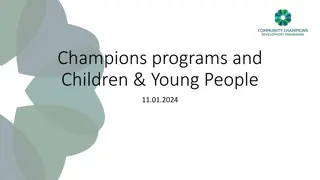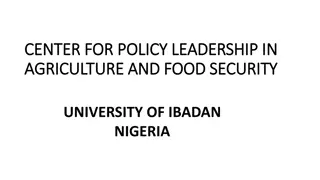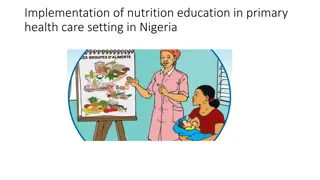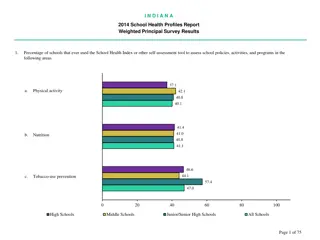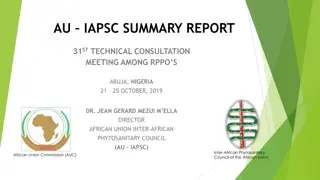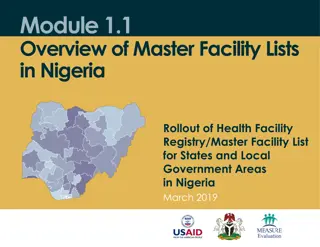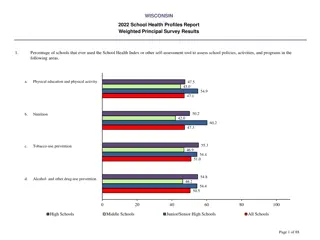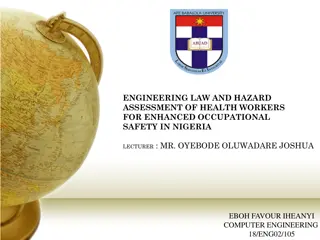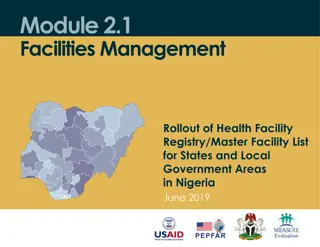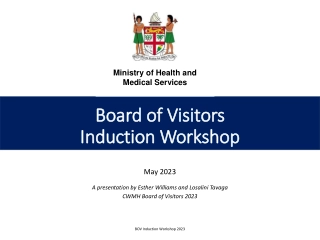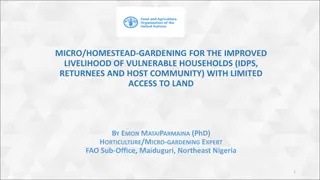Strengthening School Health Programmes in Nigeria: Workshop Overview
The School Health Programme (SHP) in Nigeria faces challenges in implementation despite established guidelines. This workshop organized by WAHEB aims to reorient and empower public health tutors/PHNOs to enhance the SHP according to standard practices. Topics covered include the National School Health Policy, roles and responsibilities, and the importance of school health programmes. The training seeks to equip participants with knowledge and skills to strengthen the SHP for the well-being of school children.
Download Presentation

Please find below an Image/Link to download the presentation.
The content on the website is provided AS IS for your information and personal use only. It may not be sold, licensed, or shared on other websites without obtaining consent from the author. Download presentation by click this link. If you encounter any issues during the download, it is possible that the publisher has removed the file from their server.
E N D
Presentation Transcript
SCHOOL HEALTH PROGRAMME (SHP) BY MRS E.I. OGUNDOJU AT A 3-DAY WORKSHOP ORGANISED BY WAHEB FOR PUBLIC HEALTH TUTORS/PHNOs (ENUGU, APRIL 23RD- 27TH, 2018)
INTRODUCTION The school environment has been described as one of the unique settings for children and adolescents to learn and to live, as well as offering resources for promoting their health and development. The school has direct contact with more than 95% of the nation s children aged 5-l7 years for about 6 hours a day and for up to 13 critical years of their social, psychological, physical and intellectual development. In Nigeria and world over, much concern and attention had been given to school health programme (SHP) to appraise, protect and promote the health of the school population most especially the school children because of their exposure to various physical, emotion and mental hazards as well as communicable diseases which are highest during the school period when the child comes in contact with people outside his family.
INTRODUCTION CONTD. It is saddening to say that all efforts at addressing the school health program in Nigeria have remained largely at policy level with minimal or non-compliance with implementation guidelines which put the status of the SHP at a poor state evidenced in the Rapid Assessment of School Health System in Nigeria conducted in 2001 by the FME in collaboration with FMOH and WHO. Consequently, the National School Health Policy (NSHP) and Implementation Guidelines was formulated in year 2006 to serve as a point of reference in providing sound foundation for planning, organization and management of SHP at all levels.
INTRODUCTION CONTD Therefore WAHEB is organizing this training workshop to orientate the participants to reactivate and strengthening the program in compliance with the established guidelines of standard of practice.
OUTLINE Overview of School Health Program National School Health Policy (NSHP) & Its Implementation guidelines Roles and Responsibilities of school health team and PHNO in the effective implementation of School Health Services and School health programme. Use of the School Assessment and Learner s health records forms
LEARNING OBJECTIVES At the end of the training, participants will be able to: Define school health programme State the concepts of school health programme Explain why school health program is important. Discuss the historical background of SHP in Nigeria List different types of school-component models List and describe five major components of school health programme as contained in the national school health policy (NSHP).
LEARNING OBJECTIVES CONTD. Identify and explain the concept of National School Health Policy (NSHP)and its Implementation Guidelines State the main goal and aims of National School Health Policy (NSHP) Mention the implementation strategies List the ideal members of a school health team. Discuss Parent-Teacher Association Identify their roles as lecturers and tutors in the training of students in various institutions Explain key terms
DEFINITIONS OF SCHOOL HEALTH PROGRAM School Health Program is defined as one of the strategies for promoting primary health care services in the school community to keep them in a state of complete, physical, mental and social well -being throughout the years of schooling and to ensure overall healthy development of learners and optimum performance of the staff.
DEFINITIONS CONTD. SHP in the context of the national school health policy is also defined as a series of harmonized projects/activities in the school environment for the promotion of the health and development of the school community and this involves the collaborative efforts of the stakeholders (i.e. theschool administrators/teachers, parents, the community, agencies and health personnel. (NSHP,2006)
CONCEPT The school health program (SHP) is one of the community health practice introduced into the schools many decades ago to ensure overall healthy development of learners and optimum performance in their education. Literature reviewed that this program has developed from a narrower concept of health examination to comprehensive health care and well -being of children throughout school years and after leaving the school.
CONCEPT CONTD. The School Health programme was designed to: Ensure that the school pupils are as healthy as possible. Obtain the maximum benefit from his/her education with the learning environment safe and conducive for learning. The main goal of the School Health Program is to improve the health of learners and teaching staff. The Programme comprises of various components. UNESCO has introduced FRESH framework to guide those wishing to set up school health program around the world which includes formulation of school health policies as one of its components.
HISTORICAL BACKGROUND OF SHP IN NIGERIA Dr. Isaac Ladipo Oluwole the first African and first Nigerian Medical Officer of Health for Lagos colony and the father of Public Health in Nigeria pioneered the establishment of school health service in Lagos in1925 using the sanitary attendants to carry out the services of regular inspection of the schools, and vaccination of the primary school children. The establishment of the school health service was informed by the general poor sanitary conditions and practices of 57 schools visited by him in Lagos area
HISTORICAL BACKGROUND OF SHP IN NIGERIA CONTD. The health office was at 43 Broad Street in Lagos. In 1929, regular inspection of school children started in Ibadan. In 1930, regulations were enacted that made it necessary for mandatory sanitary inspection of schools and health inspection of learners every 3years. The major objectives were to discover ailments some children have contracted, to provide medical treatment to alleviate the ailments and educate school teachers about better practices in hygiene and sanitation. Gradually the mid-day meal for school children and training of school food vendor was introduced and incorporated into the component of school health service
HISTORICAL BACKGROUND OF SHP IN NIGERIA CONTD. Studies showed that the Rapid Assessment of School Health System in Nigeria conducted in 2001 by the FME in collaboration with FMOH and WHO noted that the health status of the school health program was poor. In 2006, Nigeria has created its National School Health Program according to the recommendations of the WHO and the World Educational Forum using the FRESH document to formulate a national school health policy to put in place a national framework for coordination, implementation and effective monitoring and evaluation of SHP, including the roles of the different stakeholders
SHP COMPONENT MODELS There are varieties of models namely: The Three-Component Model The Eight-Component Model The Full-Service Schools Model The five-component model (NSHP,2006)
The Three- Component Model This is considered as the traditional component model of a SHP originated in the early 1900s and evolving through the 1980s. As the name implies, it consists of the followings: Health education/instruction Health services and Healthful environment
THE EIGHT-COMPONENT MODEL (co- ordinated) In the 1980s, the three-component model was expanded to include additional eight essential components bellow: health education health services healthy school environment physical education
THE EIGHT-COMPONENT MODEL CONTD. nutrition services health promotion for school staff counselling, psychological, and social services and parent and community involvement (Kolbe, 1986; Allens-worth and Kolbe, 1987)
DIAGRAMMATIC REPRESENTATION OF THE EIGHT-COMPONENT MODEL
THE FULL-SERVICE SCHOOLS MODEL This model consists of the followings: Housing Health nutrition Libraries Parks and recreation Mental health Family services mentoring
THE FIVE-COMPONENT MODEL This is the recent model as contained in the national school health policy of Nigeria. This has been in operation since 2006. They are: Healthful school environment School Feeding Services Skilled- based Health Education School Health Services School, Home and Community Relationships (NSHP, 2006)
Healthful School Environment Healthful school environment is a sub-division of SHP which is concerned with the physical setting and the psycho-social environment that favours effective teaching-learning process. The school environment should be a place where students are free from danger, disease, physical harm or injury; where sufficient water and sanitation facilities are provided and where physical structures including school location, building (light, air) class room and furniture (seating arrangement), play -ground facilities and equipment; road signage and markings etc. and sound, welcoming and secure
Healthful School Environment CONTD. The psycho-social environment is the social and emotional climate conducive for all round development. The school environment should be a place where all students are free from fear or exploitation, and where codes against misconduct exist and are enforced. Strategies for its realisation include age-appropriate school curriculum; break time, games, formation of school societies, effective Parent Teachers Association and good interpersonal relationships and communications between staff, pupils/students and between staff and pupils/students
School Feeding Services This is traditionally known as school meals. it is the provision of a supplementary adequate meal each school day for all school children to ensure that each child gets what might be missing in his/her diet at home or supplying at least one third of the daily of all major and micro- nutrients as well as maintain lifelong, healthy eating patterns
School Feeding Services CONTD The objectives include: reducing hunger and malnutrition enhancing participatory learning improving enrolment and attendance, Serving as avenue for teaching basic hygiene and nutritional facts to learners etc.
The objectives CONTD. home-grown school feeding and health program (HGSFP) subsidized mid-day meal well-planned daily menu time table( nutritionist /dietician) Use of the locally available or grown food stuff
School meal CONTD. School meal services include: food inspection food time table periodic training medical examination of school food vendors or school food handlers and periodic and environmental assessment of the school meal and personnel respectively
Skilled- Based Health Education This is the specific portion of the school curriculum devoted to health education that uses participatory exercises to assist students to acquire knowledge and develop the attitudes and skills required to adopt healthy behaviours. The curriculum is adapted to the different age groups, background, culture and beliefs of learners with the use of teaching-learning materials
School Health Services These are preventive, promoting, curative and restorative services provided for both learners and staff within the school setting and one of components of SHP. The purpose of the services is to help children at school to achieve the maximum health possible for them to obtain full benefits from their education. The objectives include to: provide basic services for diseases prevention; and management of injuries in the school, early identification and prompt intervention of health problems, etc. Components of school health services include: Routine health appraisal of school children; Prevention and Control of communicable diseases, nursing services including health counselling and education and Monitoring and evaluation. School health services are provided by the health team.
School, Home and Community Relationships This involves the good relationship that should exist between the school, home and community within which the school is situated to promote peaceful co- existence. Note There is no one universally acceptable definition and no best model of a school health program, the following essential elements should be considered in designing the program: School health Services which include medical examinations, psychological, and social services, nutrition and food services
Note CONTD. Education, which includes health education, physical education and other curricular areas which promote healthful behaviour and an awareness of health issues as part of their core instruction. School Environment, which includes the physical and the psychosocial environment Community Participation, which includes parent and community involvement which consists of involving a wide range of community stakeholders parents, students, educators, health and social service personnel, insurers, and business and political leaders to develop and form the structure of the school health program tailored to meet each local community s needs, resources, perspectives, and standards
Note CONTD. School Health Service is an essential component of school health program that provides School Health Care Package Services while SHP is a combination of many interrelated activities which may include health service, school environment protection service and others. The NSHP has 5 components as against the traditional 3 components
CONCEPTS OF THE NATIONAL SCHOOL HEALTH POLICY (NSHP) The National School Health Policy (NSHP) is an operational procedure which is to be used as guide or a point of reference on implementation of effective school health program at all levels in Nigeria. The policy is aimed at implementing child friendly school environment by assigning responsibilities and roles to relevant stakeholders. The policy was originally signed into operation in 2006 and to be reviewed every five years The policy is to comply with global trends and meet the World Health Organization (WHO) standard for schools
The Need for National School Health Policy (NSHP) To improve the general poor state of the School Health Programme and its practice that lacks standards in Nigeria. To be used as guide and appropriate national directions on implementation of effective school health program at all levels in Nigeria
The Objectives of the National School Health Policy This includes: Provision of the necessary legal framework for mobilization of support for the implementation and sustainability of the School Health Program Building the capacity of stakeholders for the implementation of the School Health Program Facilitating effective monitoring and evaluation of the School Health Program
Implementation Strategies of the Policy Planning: using a copy of the implementation guidelines to guide the implementation Capacity building- orientation of school health personnel, school based management committee, school health implementers and school health team for the acquisition of appropriate knowledge and continuous skills development. Partnership and collaboration with community health committees and other line ministries Advocacy and resource mobilization Research and Knowledge Sharing ( e.g. students project) Monitoring and evaluation in form of school inspection
The School Health Team Medical Officer Health Educator School Health Nurse/Public Health Nursing Officer Trained health teachers or trained First Aider Dental technician Social worker Environmental Health Officers, Community Health Workers (CHEW, CHO) School guidance counsellors and Nutritionist or Dietician (NSHP, 2006)
Key Roles and Responsibilities of the School Health Team Assessment: finding out the number of schools in the community and their geographical locations Display map of the catchment areas on the wall of the school clinic Cluster schools and attach them to SHP participating schools most especially the disadvantaged or underserved schools Advocacy and mobilization of stakeholders in the community including the PHC coordinator Prepare an annual work plan
Key Roles and Responsibilities CONTD. Partner with the community and intimate them with the available health care services School health care package services include: Routine health appraisal of both learners and school personnel including pre-entry medical and dental examination, physical examination; anthropometric measurements, visual and hearing screening; laboratory investigations-genotype, blood group, stool and sputum microscopy, Pre-employment medical/health examination, periodic medical examinations; screening (refer to child health records). Routine daily inspection of learners
Key Roles and Responsibilities CONTD Regular deworming exercise First-Aid /Emergency preparedness Inspection of the school environment Sick bay services including treatment of minor ailments and emergencies and immunizations School meal services including food inspection, food time table and training of food vendors Health education for learners, school community and parents (accidental/incidental) Home visits
Key Roles and Responsibilities CONTD. Referral and follow-up (network the nearest health facility) Prevention and Control of communicable diseases and non- communicable diseases Counseling and advisory services for the school community and parents Organize PTA and community (in which the school is situated) meetings to discuss health related issues Cooperation between the school head teachers and principals and the health team Monitoring and evaluation Report writing (quarterly) Record keeping using the school health record Monitoring and evaluation
Roles of PHNO in the effective management of School Health Program Administrative /Supervisory role: participate in the organisation of SHP at the national or state level and development of nursing activities in the school setting or at the state level and supervision of other health workers and staff and preparation of annual work plan Functional role: including routine clinical functions including health appraisal of learners, periodic medical examination of staff , case finding and treatment, referral, and follow up services
Roles of PHNO CONTD. Educational role: including health counselling, health and population education programmes in the school using various methods and media to maintain the health of the school community e.g. cleanliness campaigns, health parades, inter class competition e.t.c. Role in research: keep careful and systematic records and reports relating to SHP to provide valuable data upon which research may be based Role in evaluation: monitor and evaluate health services in accordance with the national school health policy and its implementation guidelines to assist in future planning NOTE: where there is no health team, PHNO takes up the responsibilities of the team as stated above
ROLE OF TUTORS/LECTURERS IN SHP As tutors/lecturers, the government is counting on your experiences for the following: In-depth study and discussions on SHP including the national school health policy and its implementation guidelines More inputs as to how the policy can be clearer, simpler without changing the content and Training of students Monitoring of students during their clinical postings
Process of conducting school assessment Identify the school to be visited Gain the school authority consent in advance On arrival, introduce yourself to the head teacher/principal or the best informed staff in a friendly manner with a few words to put the person in the right frame of mind Where there is no pre-consent letter, humbly show the school a letter of authority from SPHCDB or MOE.
Process of conducting school assessment CONTD. Never adopt an apologetic manner or hope you are not busy question rather always have a positive approach Follow instructions on the check list and complete accurate fillings Counsel and correct where necessary and make good impression Write your findings Sign the visitors book where applicable Appreciate the school Follow- up later to ensure all correction have been effected
International Development Partners (IDP) for SHP World Health Organisation UNESCO(United Nations Educational And Scientific Organisation) World Bank USAID(United Nations Educational, Scientific and Cultural Organization) UNICEF (United Nations Children Fund)
KEY TERMS School community: A community school is both a place and a set of partnerships between theschool and other community resources. Its integrated focus on academics, health and social services, youth and community development and community engagement leads to improved student learning, stronger families and healthier communities The School Environment refers to either the physical and socio-emotional environment, or aspects of the school or learning space that affects both the physical and socio-emotional well-being of students
KEY TERMS CONTD. FRESH FRESH is an acronym for Focusing Resources on Effective School Health. It is one of the strategies launched by the World Educational Forum in Dakar for achieving the effectiveness of school health programme in all countries of the world. This strategy promotes four main components of any National School Health Programme: (i) School-based Nutrition; (ii) Water, Environment, and Sanitation; (iii) School Health Policies; (iv) School-based health services. It was a partnership sponsored document by UNESCO, UNICEF, the World Bank and the World Health Organisation and Education International
KEY TERMS CONTD. Parent-Teacher Association (P.T.A) It is a formal non-profit dedicated organization composed of parents/guardians, teachers and staff to supporting the education of students from preschool through high school. They occur in both public primary and post primary and private institutions in Nigeria and also in International Schools. In Nigeria, PTA is backed by law in some states making it compulsory for parents and teachers; while in other states it is voluntary. Whichever way, parents mandatorily pay levies agreed by the association for their wards attendance in that particular school. Goal: to facilitate parental participation in the school




